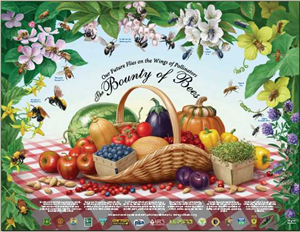
" Bounty of Bees" 2008 Pollinator Poster. Credit: Steve Buchanan
WHY
POLLINATORS ARE IMPORTANT
Pollinators, such
as bees, birds, bats and insects, play a crucial role
in flowering plant reproduction and in the production of most
fruits and vegetables.
Examples of crops that are pollinated include apples, squash, and almonds. Without the assistance of pollinators, most plants cannot produce fruits and seeds. The fruits and seeds of flowering plants are an important food source for people and wildlife. Some of the seeds that are not eaten will eventually produce new plants, helping to maintain the plant population.
Honey bees pollinate approximately $15 Billion worth of crops in the U.S. each year. The value of pollination services provided by native bees and other wildlife is even greater. It is estimated that honeybees only pollinate 15% of the most common food crops worldwide.
A recent study of the status of pollinators in North America by the National Academy of Sciences found that populations of honey bees (which are not native to North America) and some wild pollinators are declining. Declines in wild pollinators may be a result of habitat loss and degradation, while declines in managed bees is linked to disease (introduced parasites and pathogens).
WHAT IS POLLINATION?
Pollination results when the pollen from the male part of the flower (stamen) is moved to the female part of the same or another flower (stigma) and fertilizes it, resulting in the production of fruits and seeds. Some flowers rely on the wind to move pollen, while other rely on animals to move pollen.
Animals visit flowers in search of food and sometimes even mates, shelter and nest-building materials. Some animals, such as many bees, intentionally collect pollen, while others, such as many butterflies and birds, move pollen incidentally because the pollen sticks on their body while they are collecting nectar from the flowers. All of these animals are considered pollinators.
This presentation provides an introduction to pollinators. The Birds and the Bees and . . .The Beetles? Why we should care about pollinators (Print quality 5 MB or Screen Quality 3.5 MB) was developed for refuges, nature centers, scouts, 4-H, and other leaders to download and use as an introduction to local observation of pollinators.
|
|
